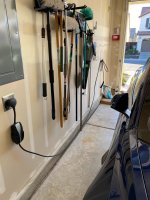Yeah, 32a is plenty, there's not much difference in 29-30 mi/hour vs. 36-37 mi/hour, in an 8-10 hour overnight charge, and since most charging is more like restoring 20-25% battery, that's just a few hours either way.
A couple of FYI for
@BigMcGuire
For continuous power, you should only use 80% of the rated max current for a circuit, i.e., a 50a circuit (breaker) should only be used at a max of 40a, which is why you never see plugin chargers rated at more than 40a, since 50 is the most for standard NEMA outlets vs. hard wiring.
There are two 50a NEMA outlet specs, an N6-50 (3-prong, 3-wire) and an N14-50 (4-prong, 4-wire). The latter is an extra neutral that allows for 2-phase, so the outlet can supply both 120v and 240v which is not needed for any EV, that's a design that's common for an RV/RV parks where they want a single cable to provide both voltages (like for lights and a stove).
The N6-50 is a common outlet for heavy shop equipment, like a welder, it only supplies 240v.
I mention this because a longer run of 4-wire can get a bit more costly vs. a 3-wire run, and the latter has no downside for an EV. In fact, that's what I had installed (N6-50). Some people will bring up the ability to use a mobile charger at an RV park, but that's not a use case that will ever come up for us, if it was, I'd just get a N14-50 adapter for the TMC which we only use for travel (and really just carry it as a backup).
That's why you see most companies offering both, if there was a specific advantage/concern/etc., they'd lean into a single outlet spec:


